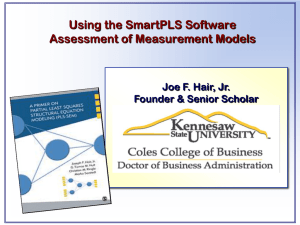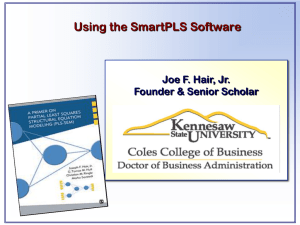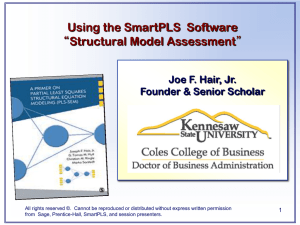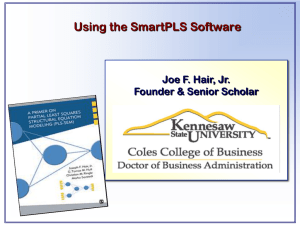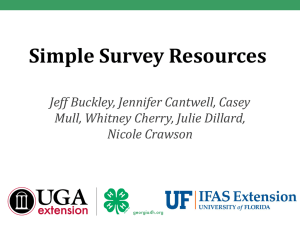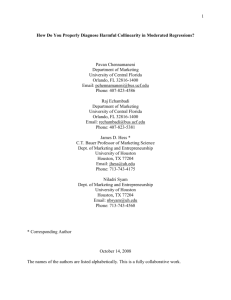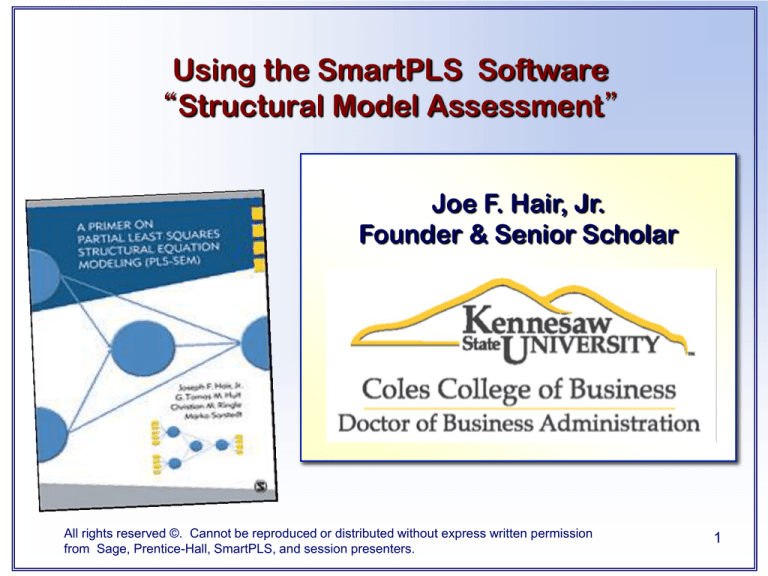
Using the SmartPLS Software
“Structural Model Assessment”
Joe F. Hair, Jr.
Founder & Senior Scholar
All rights reserved ©. Cannot be reproduced or distributed without express written permission
from Sage, Prentice-Hall, SmartPLS, and session presenters.
1
Structural Model Assessment
Once the construct measures have been confirmed as reliable and
valid, the next step is to assess the structural model results. This
involves examining the model’s predictive capabilities and the
relationships between the constructs. Exhibit 6.1 (next slide) shows a
systematic approach to the assessment of structural model results.
Before assessing the structural model, you must examine the
structural model for collinearity (Step 1). The reason is that the
estimation of path coefficients in the structural model is based on OLS
regressions of each endogenous latent variable on its corresponding
predecessor constructs. Just as in a regular multiple regression, the
path coefficients may be biased if the estimation involves significant
levels of collinearity among the predictor constructs.
After checking for collinearity, the key criteria for assessing the
structural model in PLS-SEM are: Step 2 – the significance of the path
coefficients, Step 3 – the level of the R² values, Step 4 – the f² effect
size, and Step 5 – the predictive relevance (Q² & the q² effect size).
All rights reserved ©. Cannot be reproduced or distributed without express written permission
from Sage, Prentice-Hall, SmartPLS, and session presenters.
2
Step 1: Collinearity Assessment
To assess collinearity, we apply the same measures as in the
evaluation of formative measurement model indicators (i.e., tolerance
and VIF values). To do so, we need to examine each set of predictor
constructs separately for each subpart of the structural model. For
instance, in the model shown in Exhibit 6.2 (next slide), Y1 and Y2
jointly explain Y3. Likewise, Y2 and Y3 act as predictors of Y4.
Therefore, you need to check whether there are significant levels of
collinearity between each set of predictor variables (constructs). In other
words, you need to check the collinearity between Y1 and Y2 as well as
between Y2 and Y3.
Similar to the assessment of formative measurement model
indicators, we consider tolerance levels below 0.20 (VIF above 5.00) in
the predictor constructs as indicative of collinearity that is too high. If
collinearity is exceeds these thresholds, you should consider eliminating
constructs, merging predictors into a single construct, or creating
higher-order constructs to deal with collinearity problems.
All rights reserved ©. Cannot be reproduced or distributed without express written permission
from Sage, Prentice-Hall, SmartPLS, and session presenters.
4
All rights reserved ©. Cannot be reproduced or distributed without express written permission
from Sage, Prentice-Hall, SmartPLS, and session presenters.
5
Evaluating Construct Collinearity – Extended Reputation Model
The following sets of
(predictor) constructs are
run to assess collinearity:
(1) ATTR, CSOR, PERF,
and QUAL as predictors of
COMP; (2) COMP and LIKE
as predictors of CUSA; and
(3) COMP, LIKE, and CUSA
as predictors of CUSL.
All rights reserved ©. Cannot be reproduced or distributed without express written permission
from Sage, Prentice-Hall, SmartPLS, and session presenters.
6
Evaluating Construct Collinearity – Extended Reputation Model
.
To assess construct collinearity, run the extended reputation model and open
the default report by going to Menu → Report → Default Report. Next, you
need to extract the latent variable scores from the default report, which you can
find under PLS → Calculation Results → Latent Variable Scores. The scores
are shown on this slide. Copy these scores to an SPSS file to run this analysis
(right click to highlight scores, left click to copy, then paste in SPSS).
Using the SPSS linear regression option, the following sets of (predictor)
constructs are run to assess collinearity: (1) ATTR, CSOR, PERF, and QUAL as
predictors of COMP; (2) COMP and LIKE as predictors of CUSA; and (3) COMP,
LIKE, and CUSA as predictors of CUSL.
The SPSS steps for testing collinearity are shown on the next slide for the first
All rights reserved ©. Cannot be reproduced or distributed without express written permission
7
regression
run.
from Sage, Prentice-Hall, SmartPLS, and session presenters.
Using SPSS to Assess Collinearity
.
These are the
four exogenous
constructs that are
being tested for
multicollinearity.
All rights reserved ©. Cannot be reproduced or distributed without express written permission
from Sage, Prentice-Hall, SmartPLS, and session presenters.
8
Evaluating Collinearity Among Exogenous Constructs
Below are the SPSS collinearity results from using
ATTR, CSOR, PERF, and QUAL as predictors of COMP.
All VIF values
are clearly below
the threshold of 5.
All rights reserved ©. Cannot be reproduced or distributed without express written permission
from Sage, Prentice-Hall, SmartPLS, and session presenters.
9
Evaluating Collinearity Among Exogenous Constructs
Below are the collinearity results from using COMP and LIKE as
predictors of CUSA (top table), and COMP, LIKE and CUSA as predictors
of CUSL (bottom table). All VIF values are well below the threshold of 5.
All rights reserved ©. Cannot be reproduced or distributed without express written permission
from Sage, Prentice-Hall, SmartPLS, and session presenters.
10
Step 2: Assess Significance and Relevance
of the Structural Model Relationships
After applying the PLS-SEM algorithm, estimates are
obtained for the structural model relationships (the path
coefficients), which represent the hypothesized relationships
between the constructs.
The path coefficients for the structural model are shown
in the next several slides. These results were obtained from
the SmartPLS Default Report with the following sequence:
PLS Algorithm → Calculation Results → Path Coefficients
Before examining the sizes of the path coefficients we
will first examine their significance. To do so, we must first
run the Bootstrapping option.
All rights reserved ©. Cannot be reproduced or distributed without express written permission
from Sage, Prentice-Hall, SmartPLS, and session presenters.
11
Reputation Model Results
– Path Coefficients –
All rights reserved ©. Cannot be reproduced or distributed without express written permission
from Sage, Prentice-Hall, SmartPLS, and session presenters.
12
Bootstrapping
Which path coefficients
are significant?
Click here to run
Bootstrapping
When you run
bootstrapping select
mean replacement for
missing data, no sign
changes, your actual
sample size = cases, and
5,000 samples.
All rights reserved ©. Cannot be reproduced or distributed without express written permission
from Sage, Prentice-Hall, SmartPLS, and session presenters.
13
Bootstrapping Default Report – Significance of Path Coefficients
T Statistics are found
beside the tab below.
.
The above results show the significance of the path coefficients. Recall that
a T Statistic > 1.96 is significant with a two-tailed test, and >.98 is significant for a
one-tailed test. Note: path coefficients are shown in Original Sample column.
The results indicate that all paths are statistically significant using a one-tailed
test except COMP – CUSL. But eight of the thirteen structural paths are
significant based on a two-tailed test.
All rights reserved ©. Cannot be reproduced or distributed without express written permission
from Sage, Prentice-Hall, SmartPLS, and session presenters.
14
Obtaining the Default Report to
Evaluate Path Coefficients
Click here to obtain
Default Report
All rights reserved ©. Cannot be reproduced or distributed without express written permission
from Sage, Prentice-Hall, SmartPLS, and session presenters.
15
SmartPLS Default Report – Path Coefficients
After examining the significance of relationships, it is important to assess the
relevance of significant relationships. Path coefficients in the structural model
may be significant, but their size may be so small that they do not warrant
managerial attention.
Structural model path coefficients can be interpreted relative to one another.
If one path coefficient is larger than another, its effect on the endogenous latent
variable is greater. More specifically, the individual path coefficients of the path
model can be interpreted just as the standardized beta coefficients in an OLS
regression. These coefficients represent the estimated change in the
endogenous construct for a unit change in a predictor construct.
All rights reserved ©. Cannot be reproduced or distributed without express written permission
from Sage, Prentice-Hall, SmartPLS, and session presenters.
16
PLS Algorithm Default Report – Path Coefficients
Looking at the relative importance of the exogenous driver constructs in
predicting the dependent construct perceived competence (COMP), we see that
customer perceptions of the company’s quality of products and services (QUAL =
0.4297) is most important, followed by performance (PERF = 0.2955). In
contrast, the perceived attractiveness (ATTR = 0.0861) and degree to which the
company acts in socially conscious ways (CSOR = 0.0589) have very little
influence on COMP. These last two drivers are, however, more important in
predicting a company’s likeability (LIKE) – ATTR = 0.1671 and CSOR = 0.1784,
but the most important predictor of LIKE is QUAL (0.3800).
When you examine the endogenous likability construct (LIKE) you see that it
is the primary driver (predictor) of customer satisfaction (CUSA = 0.4357), and a
meaningful
predictor
of loyalty
(CUSL
= 0.3440),
and COMP
has little impact on17
All rights reserved
©. Cannot
be reproduced
or distributed
without express
written permission
from(0.0057).
Sage, Prentice-Hall, SmartPLS, and session presenters.
CUSL
Understanding Direct and Indirect Effects
Researchers are often interested in evaluating not only one
construct’s direct effect on another but also its indirect effects via
one or more mediating constructs. The sum of direct and indirect
effects is referred to as the total effect.
In Exhibit 6.4 on the next slide, constructs Y1 and Y3 are
linked by a direct effect (p13 = 0.20). In addition, there is an
indirect effect between the two constructs via the mediating
construct Y2. This indirect effect can be calculated as the product
of the two effects p12 and p23 (p12 x p23 = 0.80 x 0.50 = 0.40). The
total effect is 0.60, which is calculated as p13 + (p12 x p23) = 0.20 +
(0.80 x 0.50) = 0.20 + 0.40 = 0.60.
Although the direct effect of Y1 to Y3 is not very strong (i.e.,
0.20), the total effect (both direct and indirect combined) is quite
pronounced (i.e., 0.60), indicating the relevance of Y1 in explaining
Y3. This type of result suggests that the direct relationship from Y1
to Y3 is mediated by Y2.
All rights reserved ©. Cannot be reproduced or distributed without express written permission
from Sage, Prentice-Hall, SmartPLS, and session presenters.
18
.
PLS Algorithm Default Report – Total Effects = Sizes
The four driver constructs for loyalty (CUSL) are the exogenous
constructs on the left side of the SEM model (these constructs are
actionable because they are formative and thus of primary concern
for the total effects analysis). The findings shown above indicate that
quality (QUAL = 0.2483) has the strongest total effect on loyalty,
followed by corporate social responsibility (CSOR = 0.1053),
attractiveness (ATTR = 0.1010), and performance (PERF = 0.0894).
Note that there are three mediating constructs (COMP, CUSA &
LIKE) between the exogenous driver constructs and the endogenous
construct CUSL whose role must be considered, but they are
relatively less actionable because they are reflective – not formative.
All rights reserved ©. Cannot be reproduced or distributed without express written permission
from Sage, Prentice-Hall, SmartPLS, and session presenters.
20
Bootstrapping Default Report – Total Effects = Significance
You can also examine the significance of the total effects. Above are
the T statistics for the total effects from the bootstrapping default report.
All rights reserved ©. Cannot be reproduced or distributed without express written permission
from Sage, Prentice-Hall, SmartPLS, and session presenters.
21
.
Note: In the above table we only show the total effects for the four exogenous
driver constructs to the satisfaction and loyalty endogenous constructs,
All rights reserved ©. Cannot be reproduced or distributed without express written permission
22
because these
areand
thesession
outcomes
the company is most interested in managing.
from Sage, Prentice-Hall,
SmartPLS,
presenters.
To get outer weights:
PLS → Calculation Results → Outer Weights
Identifying actionable
strategies based on
sizes of exogenous
construct weights.
By examining the outer weights of the construct indicators, we can identify which
specific element of quality (QUAL) needs to be addressed. Note that qual_6 has the
highest outer weight (0.3980). This survey question was “[the company] seems to be
a reliable partner for customers” so perceptions of reliability should be enhanced and
communicated to customers.
23

